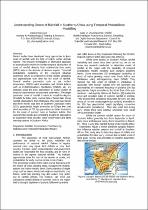 ResearchSpace
ResearchSpace
Understanding onsets of rainfall in Southern Africa using temporal probabilistic modelling
JavaScript is disabled for your browser. Some features of this site may not work without it.
- ResearchSpace
- →
- Research Publications/Outputs
- →
- Conference Publications
- →
- View Item
| dc.contributor.author |
Cheruiyot, D

|
|
| dc.contributor.author |
Osunmakinde, IO

|
|
| dc.date.accessioned | 2011-02-14T12:10:22Z | |
| dc.date.available | 2011-02-14T12:10:22Z | |
| dc.date.issued | 2010-12 | |
| dc.identifier.citation | Cheruiyot, D and Osunmakinde, IO. 2010. Understanding onsets of rainfall in Southern Africa using temporal probabilistic modelling. Proceedings of the 30th IASTED Conference on Modelling, Identification, and Control, Phuket, Thailand. 24-26 November 2010, pp 1-8 | en_US |
| dc.identifier.isbn | 9780889868571 | |
| dc.identifier.issn | 19251629 | |
| dc.identifier.uri | http://hdl.handle.net/10204/4864 | |
| dc.description | Proceedings of the 30th IASTED Conference on Modelling, Identification, and Control, Phuket, Thailand. 24-26 November 2010 | en_US |
| dc.description.abstract | This research investigates an alternative approach to automatically evolve the hidden temporal distribution of onset of rainfall directly from multivariate time series (MTS) data in the absence of domain experts. Temporal probabilistic modelling of the emergent situation awareness (ESA) is proposed to reveal hidden variability and dependencies over time for the onset of rainfall. Several weather parameters such as sea surface temperature, 700hPa wind anomalies, and climate indices such as El-Niño/Southern Oscillation (ENSO), etc. are analysed using the ESA technology to evolve model of temporal dependencies among these parameters. The target parameter, onset of rainfall is meant to reveal the degrees of beliefs for false, early, normal, late or failed state. Using rainfall observations from Botswana, this work has shown that three month lead time of Southern Oscillation Index (SOI); geopotential height anomalies at 500hpa level and wind anomalies at 700 hpa parameters are better indicators for the onset of summer rains in Southern Africa. Our experimental results give promising insights to approaches to sustainable food security, water conservation and early warning systems in Southern Africa. | en_US |
| dc.language.iso | en | en_US |
| dc.relation.ispartofseries | Workflow request;5778 | |
| dc.subject | Rainfall | en_US |
| dc.subject | Food security | en_US |
| dc.subject | Temporal probabilistic models | en_US |
| dc.subject | Statistical probabilistic models | en_US |
| dc.subject | Modelling | en_US |
| dc.subject | Water conservation | en_US |
| dc.subject | Climate changes | en_US |
| dc.title | Understanding onsets of rainfall in Southern Africa using temporal probabilistic modelling | en_US |
| dc.type | Conference Presentation | en_US |
| dc.identifier.apacitation | Cheruiyot, D., & Osunmakinde, I. (2010). Understanding onsets of rainfall in Southern Africa using temporal probabilistic modelling. http://hdl.handle.net/10204/4864 | en_ZA |
| dc.identifier.chicagocitation | Cheruiyot, D, and IO Osunmakinde. "Understanding onsets of rainfall in Southern Africa using temporal probabilistic modelling." (2010): http://hdl.handle.net/10204/4864 | en_ZA |
| dc.identifier.vancouvercitation | Cheruiyot D, Osunmakinde I, Understanding onsets of rainfall in Southern Africa using temporal probabilistic modelling; 2010. http://hdl.handle.net/10204/4864 . | en_ZA |
| dc.identifier.ris | TY - Conference Presentation AU - Cheruiyot, D AU - Osunmakinde, IO AB - This research investigates an alternative approach to automatically evolve the hidden temporal distribution of onset of rainfall directly from multivariate time series (MTS) data in the absence of domain experts. Temporal probabilistic modelling of the emergent situation awareness (ESA) is proposed to reveal hidden variability and dependencies over time for the onset of rainfall. Several weather parameters such as sea surface temperature, 700hPa wind anomalies, and climate indices such as El-Niño/Southern Oscillation (ENSO), etc. are analysed using the ESA technology to evolve model of temporal dependencies among these parameters. The target parameter, onset of rainfall is meant to reveal the degrees of beliefs for false, early, normal, late or failed state. Using rainfall observations from Botswana, this work has shown that three month lead time of Southern Oscillation Index (SOI); geopotential height anomalies at 500hpa level and wind anomalies at 700 hpa parameters are better indicators for the onset of summer rains in Southern Africa. Our experimental results give promising insights to approaches to sustainable food security, water conservation and early warning systems in Southern Africa. DA - 2010-12 DB - ResearchSpace DP - CSIR KW - Rainfall KW - Food security KW - Temporal probabilistic models KW - Statistical probabilistic models KW - Modelling KW - Water conservation KW - Climate changes LK - https://researchspace.csir.co.za PY - 2010 SM - 9780889868571 SM - 19251629 T1 - Understanding onsets of rainfall in Southern Africa using temporal probabilistic modelling TI - Understanding onsets of rainfall in Southern Africa using temporal probabilistic modelling UR - http://hdl.handle.net/10204/4864 ER - | en_ZA |





